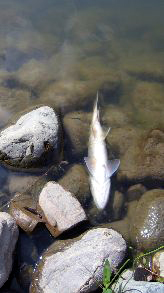The Right Fish for Your Pond
Which species of fish to add to your pond
1. The trout family
Among trouts, brook trout (Salvelinus fontinalis), or speckled trout, remains the most popular specimen in its category in Quebec. True emblem of the wild fish, it is found up to the level of the Ungava region. Locally, it inhabits waterways whose water remains fresh and oxygenated all year round, mainly mountain streams. A speckled trout will not reproduce in a pond, and will only manage to survive if the water quality and habitat are excellent. Very sensitive to temperature variations, it stops feeding as soon as the water reaches 18 °C, and dies from 23 °C. Contrary to what some fish farm vendors claim, this species is absolutely not adapted to ponds. Even if your pond is deeper than 12 feet, the lack of oxygen in these deep layers of water would be fatal to your flycatcher population. Consider using aeration to bring oxygen to these anoxic layers.
Next species is the rainbow trout (Salmo gairdneri), which seems to have become common and well adapted following the repeated and important seeding of our lakes and rivers. Brome Lake and Lake Memphremagog are good examples of its successful establishment. They resist well to pond life, provided certain conditions are met. Like the speckled trout, they like cold and sufficiently deep water, but they are more tolerant to temperature: at 23° C they stop feeding, at 28.5° C they die. On the other hand, contrary to popular belief, they do not eat frogs or tadpoles. In ponds, their life span is about 5 years.
Brown trout (Salmo trutta) are not common in ponds as they prefer streams where food in the form of small fish is more abundant. They resist to warmer waters, provided that they are well oxygenated. No trout species reproduces in ponds unless it is fed by a stream with a gravelly bed for spawning site. Nevertheless, artificial spawning grounds can be developed, acting as a permanent stream.
2. Bass, THE ideal fish for ponds of our regions
Smallmouth bass (Micropterus dolomiuei). It is not difficult to find bass around Mount Sutton. Enjoying numerous habitats in ponds, lakes and rivers, it does not require as much oxygen as trout. They will of course remain much more active in well-oxygenated grass beds than in a pond that is devoid of aquatic plants and low in oxygen. The smallmouth bass feeds up to temperatures of 28° C, it succumbs when temperatures exceed 34° C. Its diet consists mainly of insects, crayfish, frogs, tadpoles and other small fish. Without eliminating all the frogs, it will regulate their population. The frogs will quickly understand that it is better to find another habitat than your pond to lay their eggs. Frog eggs are the main food source of leeches. Bass fry are usually only available at fish farms in the fall.
Summer fish kills could be a sign that your pond is not designed for that species. Read on and discover what are the right fish for your pond.

Pond Size and Depth
Ponds ranging in size from ¼ acre to several acres can provide satisfactory sport fishing. Ponds less than ¼ acre in size will not provide adequate amounts of natural food or cover to support a healthy sport fish population.
Pond depth required depends on the climatic conditions. In areas where freezing weather is common ponds must be deeper in order to avoid the possibility of winterkill. At least 1/3 of the pond should have a depth of 6 feet or more. Ponds used for irrigation, livestock watering and other high consumption uses, or those with intermittent water sources and high evaporation rates, should be deeper than 6 feet.
Although shallow water areas serve as spawning and nursery sites for sport fish, they readily become weed-choked. To prevent excessive growth of water plants, shallow areas should be more than 2 feet deep. Also consider the establishment of floating habitats to provide refuge for your fish.
Water temperature and fish survival
Water temperature plays a critical role in determining what kinds of sport fish can survive in a particular pond. In general, freshwater fish can be separated into three groups based on temperature preferences. Coldwater species, which include brown trout, brook trout, and rainbow trout, thrive at high altitudes or in cold climates where the average surface water temperature is below 70 °F (21 °C) during the warmest months. Warm water fish such as Largemouth Bass, Bluegill sunfish, and Channel catfish can survive at water temperatures of 90 °F (32 °C) or higher and are almost never killed by high water temperatures alone. Cool water fish, which prefer an intermediate temperature range of 70° to 80°F, include Smallmouth bass, Rock bass, Walleye, Northern pike, and Pickerel. It is extremely important to match water temperature and the fish species to be stocked.


Finally, would you wish to stock fish in your own pond, you can start researching the producers of your region (in french only) to purchase the species you require.


Related Articles: